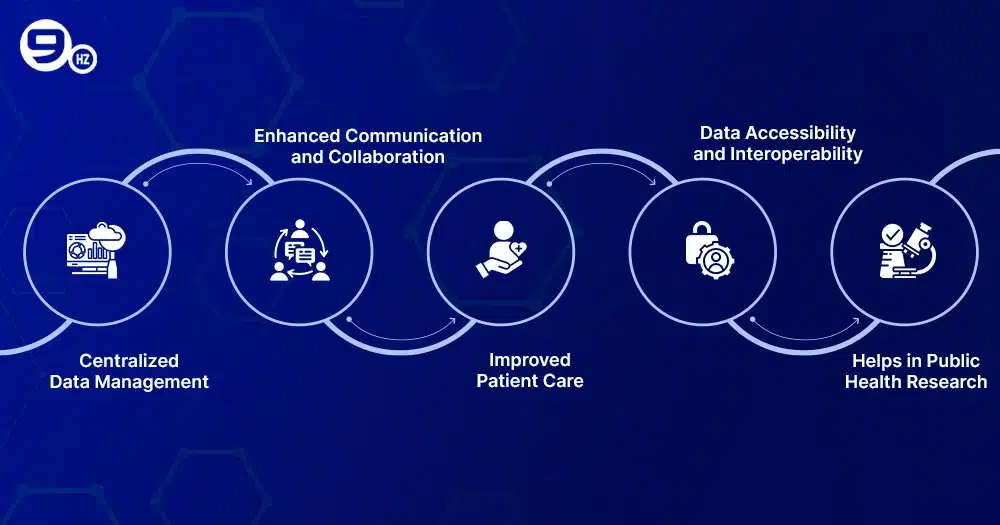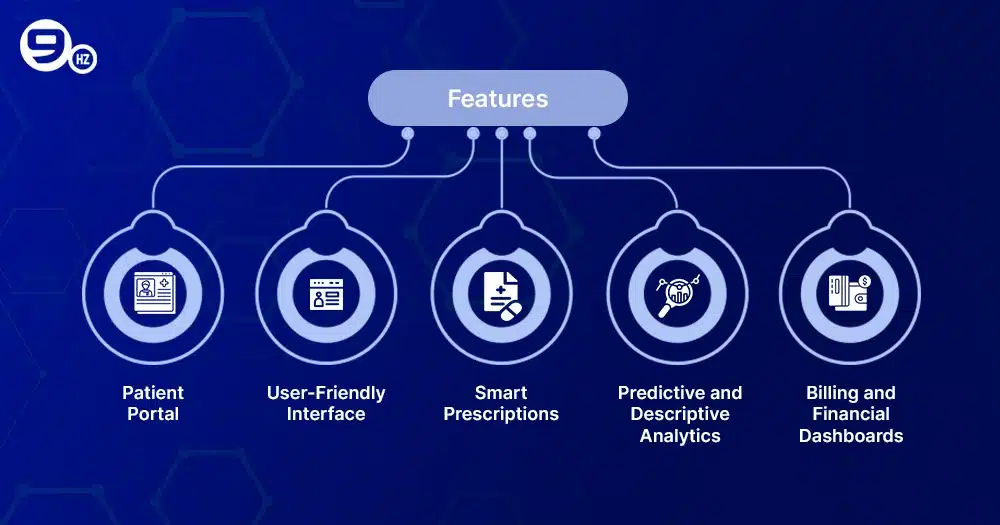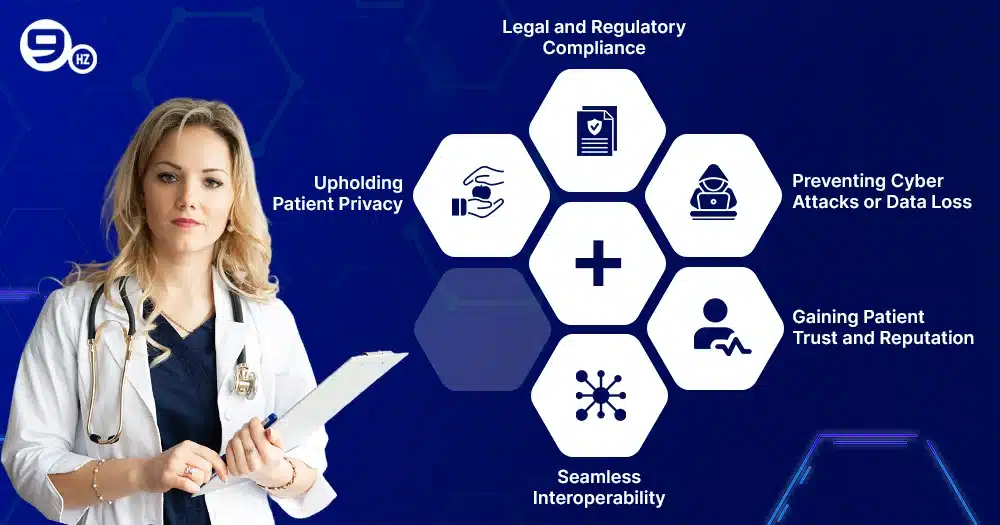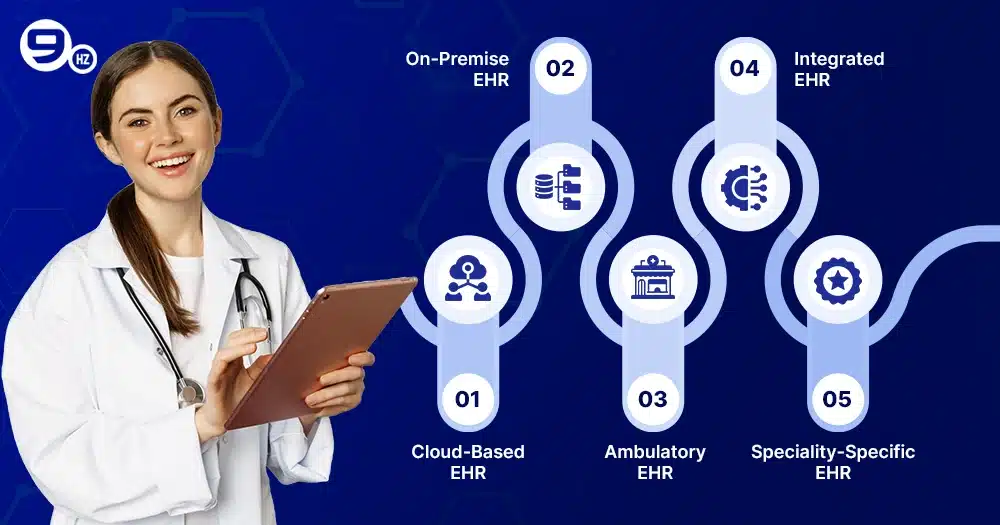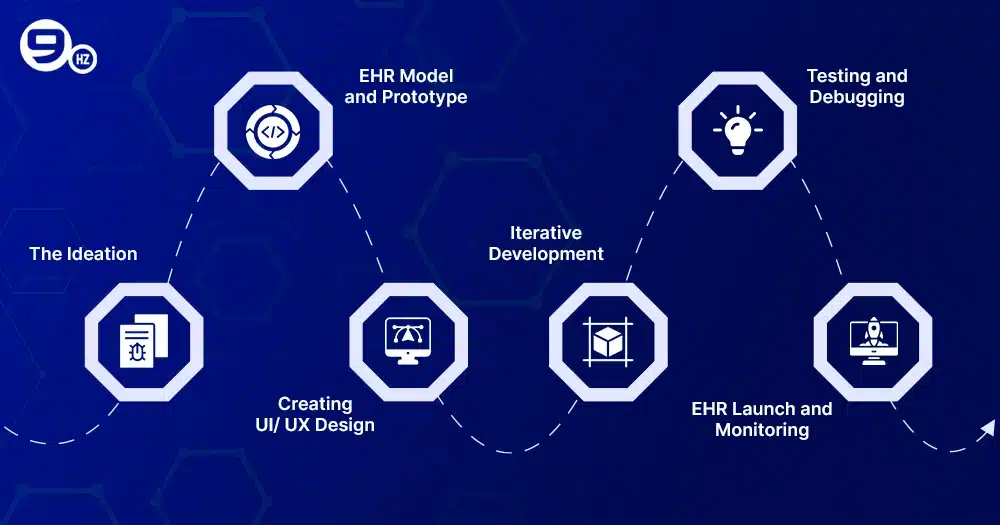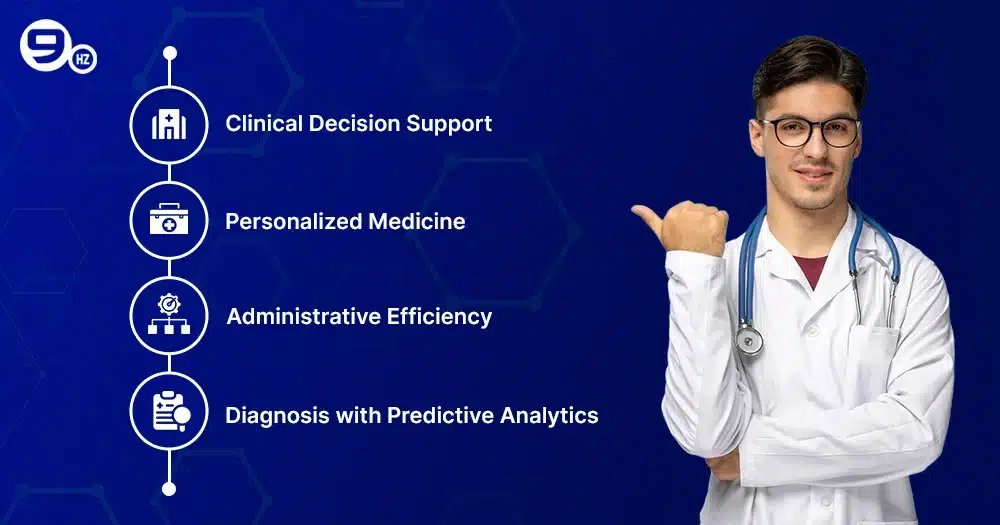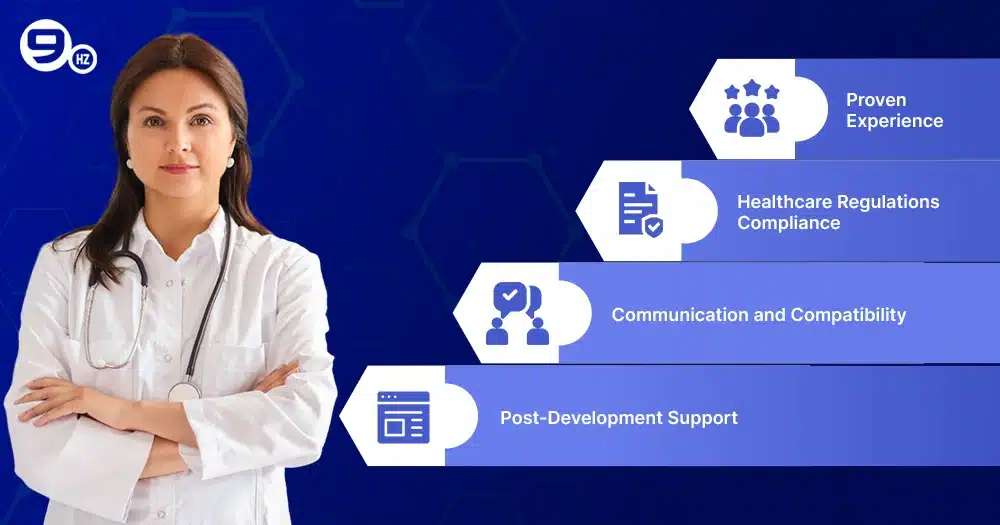Today, we see tech innovations transforming every sector, and the healthcare industry is no more an exception. In an effort to facilitate the best treatment for patients, healthcare software development services is deemed a perfect solution to render quality care through cutting-edge technological resources. Electronic Health Records (EHR) software is the transformative solution that every medical association requires to improve the productivity of physicians and serve patients in a better way. Understanding how to build EHR software is crucial for organizations looking to enhance their operational efficiency and patient care.
Want to know how? Here is a story!
Previously, managing patients’ health records was a complex task and involved hefty paperwork. A minor human error in manually filing details of each patient or losing an important document would compromise the treatment plan. To avoid this chaos, they have realized the significance of EHR software development for overcoming healthcare challenges by automating the data management process.
In fact, according to Grand View Research, the EHR market was projected to be USD 32.23 billion in 2023 which is expected to rise from 2024 to 2030 at a CAGR of 4.43%. These trends indicate the growth of healthcare IT, which is developing an efficient workflow in the medical setting to redefine diagnosis plans.
Now, the real question arises, “How to develop an EHR system?”
In this comprehensive blog, we will discuss the roadmap to an EHR software solution for your medical practice. Let’s get started!
What is EHR Software?
Electronic Health Record (EHR) software was developed with the intention of facilitating the on-demand access of information to authorized users (doctors). This system includes summaries of patients’ records, such as patient demographics, vital signs, history of diseases, diagnosis, lab testing results, progression notes, and more. This information can provide medical professionals with better insight into the patient’s condition and thereby contribute to precise diagnosis.
EHR software implementation allows medical practitioners to quickly review and share information with lab specialists, enhancing coordination and leading to fewer medical malpractices. Many hospitals have identified the need to build EHR software for their operational aspects, enabling better management of several chronic diseases. Additionally, when data is managed efficiently, it saves healthcare costs pertaining to unnecessary tests and appointment visits.
Benefits of EHR System
In recent years, we have seen widespread adoption of the EHR system in the healthcare facility. The reason behind this is its advantages for its stakeholders, such as providers, patients, and clinical specialists in the healthcare ecosystem. Here are some of the benefits to develop EHR software in the healthcare sector:
1. Centralized Data Management
EHR software development can help you manage patient data centrally, where it is stored, managed, and monitored. It eradicates the need for paper-based documents and brings efficiency for healthcare staff by streamlining basic and monotonous tasks. Within this centralized system, data access becomes easier, and clinical specialists can make better educational decisions.
2. Enhanced Communication and Collaboration
EHR software has shared access to pertinent information that enhances teamwork and collaboration within departments. When communication is seamless, it makes it easier for doctors to diagnose disease. Prior knowledge of allergies, past treatments, and medications allows doctors to avoid drug mistakes and improve care outcomes.
3. Improved Patient Care
Healthcare providers are successful in delivering quality patient care with a broad perspective of a patient’s medical history and vitals. EHR software consolidates all the necessary information to reconcile the diagnosis and, thereby, quality treatment plans. Your clinical staff will spend less time exploring the information as they can access it within a few clicks through this software.
4. Data Accessibility and Interoperability
The EHR system allows seamless integration with third-party applications by allowing smooth data exchange between the applications. It ensures that authorized individuals are given access to the information so that no wrong decisions are made. Besides, EHR software allows access to data from any location via the Internet, allowing medical practitioners to have important information at their fingertips.
5. Helps in Public Health Research
Many research organizations utilize data gathered from EHR in population management and healthcare reporting. Exchanging data across healthcare institutions and research experts ensures care coordination. For instance, the outbreak of infectious disease COVID-19 was tracked by the healthcare data identified from EHR systems to undertake a step towards public health initiatives.
Also Read:
Types of Healthcare softwares
Software development process models
Top healthcare Software
What are the Features of the EHR Software?
If you are planning to develop EHR software, be sure to add these crucial features:
1. Patient Portal
This portal contains demographic information about patients, such as names, vitals, addresses, and insurance details. Patients will be identified based on this information when they register with the hospital with a special ID. The EHR system will automate many administrative tasks, such as registration, appointment scheduling, digital payments, and the discharge process.
2. User-friendly Interface
Easy navigation, customizable dashboards, and improved accessibility are user-friendly elements that you need to take care when you build EHR software. This enables users to access the fully digitized platform where healthcare records and lab results are instantly reviewed and monitored.
3. Smart Prescriptions
With health software development services, everything has become digital, including prescriptions. In EHR software, e-prescription will play a crucial role in mitigating unnecessary paperwork and maintaining records in an organized manner. It will make information visible on demand, supporting wise clinical decision-making.
4. Predictive and Descriptive Analytics
The future of EHR solutions is not worth it without predictive analytics. It will allow visualizing patient data to predict the level of risks and identify rehab strategies. Doctors can also identify the level of risks associated with impairment in daily activities to suggest a solution that heals the condition. Real-time insights, when integrated with lab test results, increase the accuracy levels and treatment plans that align with the patient’s issues.
5. Billing and Financial Dashboards
This dashboard is helpful in recording the expenditures of each patient, which can contribute to the hospital’s productivity and profitability. It will continuously gather data from different sources and generate analytical reports for measuring staff performance. The financial department can leverage this feature of EHR software to shed light on historical revenue, billing, costs, and areas of improvement.
Why Is Compliance with HIPAA and Other Industry Standards Important for Your EHR/EMR System?
When you are developing EHR/ EMR software, regulatory compliance is imperative to protect data from manipulation. HIPAA is a critical US law that mandates the safeguarding of the confidentiality of the patient’s medical history. This compliance will protect the privacy of medical information, which is later known as Protected Health Information (PHI). Thus, every organization that uses patient data needs to establish clear guidelines on the use of a transparent disclosure of PHI.
Let’s look at some prominent reasons why you need to be HIPAA and other industry standard compliance when to develop EHR software:
1. Upholding Patient Privacy
When you make your system HIPAA compliant through strong safety measures, you tend to prevent the sensitive information of patients from being compromised. This is not only a legal obligation but also a foundational element to preserve a patient’s trust.
2. Legal and Regulatory Compliance
Healthcare organizations must adhere to HIPAA and other standards, such as the HITECH Act, as failure to do so will lead to severe consequences. Robust administrative efforts are needed to avoid violations and legal penalties.
3. Preventing Cyber Attacks or Data Loss
This standard will ensure the encryption of sensitive data and establish strong access controls that minimize the risks of data breaches. It ensures providers establish strict policies and protocols for the security of valuable medical data.
4. Gaining Patient Trust and Reputation
While you develop EHR software, diligent maintenance of HIPAA compliance will foster patient trust. Non-compliance will only impact the organization’s reputation by diminishing the satisfaction of patients.
5. Seamless Interoperability
Making your EMR/ EHR system compliant with Industry standards will also be helpful in maintaining interoperability. This means that data exchange will be smoother which would reduce redundancies and improve coordination.
Types of EHR Softwares
There are various EHR software developments that serve specific purposes and complex healthcare demands. Here are some common types:
1. Cloud-Based EHR
This EHR software solution is hosted by an IT vendor and can be accessed via the Internet from anywhere. Cloud-based EHR systems are an affordable option for smaller healthcare organizations with low maintenance expenses. They provide increased security, high scalability, and instant data backup without the requirement of outdated, lengthy hardware setups.
2. On-Premise EHR
An on-premise EHR system requires the installation of hardware and software on the healthcare organization’s server. This system has more control over data and resources and tight security, which protects customer data. Features can be customized as needed, but the maintenance cost is higher than in the cloud.
3. Ambulatory EHR
This kind of EHR software is designed for outpatient care environments, including doctors, clinical departments, and surgical facilities. With the assistance of healthcare software development services, you can develop an ambulatory EHR for healthcare firms to rigorously maintain patient records. It would provide information and ensure clinical reports in an outpatient setting.
4. Integrated EHR
An integrated EHR software solution combines patient data from different healthcare facilities. This will improve data exchange across multiple healthcare systems and leverage data security to improve interoperability. Smooth data management across different providers will enhance patient coordination and continued care.
5. Specialty-Specific EHR
These EHR systems are focused on core medical specialties like cancer, cardiology, pediatrics, and dermatology. Specialty-specific EHR software has features that align with specific clinical needs. It stores and manages data based on the process and terms of the particular specialty.
Tech Stack Required to Build EHR Software
Every vendor has its healthcare software development tech stack, which is needed to put the idea into reality. The collection of technologies needs to be compatible with data management, scalability, and compliance with healthcare regulations such as HIPAA. Here are the key required tech stack needed to build EHR software:
1. Programming Languages
To build EHR software, you need to select programming languages that meet your system’s requirements for performance, high-grade security, and scalability.
• Backend Technologies
These include technologies related to the logic and data processing for health records, such as Java, Python, C#/.NET, and Node.js. In most cases, Python is chosen for developing EHRs due to its compliance with HIPAA.
• Frontend Technologies
This technology is used in the UI and UX of patient-facing portals. Some of the popular frontend frameworks are JavaScript (with React, Angular, or Vue.js), TypeScript, and HTML5/CSS3, which can assist you in crafting an interactive and responsive system.
2. Application Programming Interfaces (API)
APIs in EHR software development will ensure that data is smoothly exchanged between systems. Standards like Fast Healthcare Interoperability Resources (FHIR) will ensure interoperability between healthcare facilities.
Development companies can use the GraphQL/REST (JavaScript, Python, Java) framework to develop APIs. This framework has well-established structures for running queries, ensuring a smooth exchange of patient data.
3. Database Technologies
A robust DBMS (Database Management System) is needed to handle large data loads and ensure smooth retrieval of health records.
• SQL
Structured Query Language (SQL) can be used to manage structured medical records like MySQL.
• NoSQL
You can use this database to manage unstructured data like clinical notes. For example, MongoDB can be used to manage large healthcare records.
4. Development Team
The development team’s expertise will contribute to the success of the EHR software development project. Teams need to know the niche, regulatory standards, security requirements, and custom application development requirements.
You will require the following team roles to move ahead with the EHR system development idea:
- Project Manager
- Business Analyst
- UI/UX Designer
- Frontend and Backend Developer
- Android and iOS Developers
- QA Engineers
- Database Administrator
- Healthcare Domain Expert
5. EHR System Architecture
Healthcare organizations attempt to develop the architecture of EHR software for a scalable, secured, and efficient handling of healthcare data. Here is the bifurcation of architecture for the EHR system:
• Data Layer
This layer stores vast amounts of structured and unstructured medical data.
• Application Layer
This would implement business logic into the workflows.
• Client Layer (User Interface)
This front-facing layer interacts with patients and clinical staff.
How to Build the EHR Software?
With the assistance of a competent software development company, you can build EHR software according to the customized needs of your healthcare setting. We are briefly explaining the six steps to consider for developing robust and scalable medical software.
Step 1: The Ideation
The idea of developing an EHR system is generated from the requirement analysis, which shows that medical facilities have to understand the need to implement EHRs. For that, engage with the healthcare staff to recognize the pain points in handling medical information and make a list of features required to address those hurdles. This also comes with selecting a reliable partner for EHR system development, which can assist you in preparing product requirements for developing a robust EHR design.
Step 2: EHR Model and Prototype
The next step involves creating a prototype, wherein you decide upon the functionalities you would employ in the system. It also involves identifying the team requirements and which technologies will be utilized to continue with the development. This stage will ensure that the software will work within the prescribed features, tech stack, and estimated costs.
Step 3: Creating UI/ UX Design
At this stage, organizations focus on interactive user interfaces, which are much needed to build EHR software. A robust design will ensure a positive influence on the interactions made through the EHR system. For developing an intuitive UI/ UX design, it is recommended to take care of information structuring, customized healthcare roles, system accessibility, and seamless integration with other systems.
Step 4: Iterative Development
After the design specifications are completed, it is now time to start the development process. With the help of leading programming languages, coders and software engineers will build EHR software functionalities. The process includes developing frontend and backend features, creating APIs for integration, establishing security for PHI protection, and testing the performance, compatibility, and accessibility.
Step 5: Testing and Debugging
The next step now involves the crucial role of quality assurance experts who will test the features and identify bugs. Testers will check the system’s responsiveness by deploying code into different environments before it is actually released to production. With rigorous software testing services, you can identify whether the EHR software meets the needs of the hospital setting. The testing process will continue until the development objectives are fully met, ensuring that all aspects of the software are thoroughly evaluated and validated.
Step 6: EHR Launch and Monitoring
Subsequent testing allows the team to proceed to deployment, where the software is launched in the right market and environment. EHR software is launched in the MVP version, in which performance can be analyzed, and you can work on changes. Finally, it is essential to make your team aware of the latest industry trends and make changes in security and features based on the insights gathered from feedback.
Ready-Made vs. Custom EHR Solutions
When you are getting the EHR software developed, you have two options: adopt a ready-made solution or customize it according to your needs. Both options have advantages and drawbacks that you must know.
1. Ready-Made EHR Software
Companies that have experience in developing healthcare solutions by continuously complying with the current regulations develop these solutions. They are developed for the general needs of medical facilities, owing to quick deployment and little or no upfront costs. However, limited customization tends to create a gap in functionality when it does not cater to unique needs. Likewise, additional features might create a cumbersome situation when they aren’t under the bandwidth of the healthcare organizations.
2. Custom EHR Solutions
These are bespoke EHR software that are built from ground up, keeping in mind the unique requirements of the client. They are tailored to specific departments, workflows, integration capabilities, and security needs. The system can be modified and scaled more easily than a ready-made solution, making it an ideal long-term solution. However, the cost of customized solutions is high when the organization requires some specific functionalities. It is also a time-consuming process, which can lead to delays in deployment.
How much does it cost to build the EHR Software?
The cost to build EHR software mainly depends upon the features, complexity, data migration, and customization. Here is a brief breakdown of the cost estimations for the EHR system:
- Small-size Clinic: The cost of developing a basic EHR system with essential features like patient management is $50,000 to $100,000.
- Medium-size Medical Facility: The cost for this size of practice is between $100,000 and $300,000, and it would include more sophisticated features, including lab report integration and custom templates.
- Large Hospitals: When EHR solutions are developed for big hospitals, the cost of AI integration and deep analytics can exceed $500,000.
Software Development Companies in India
Software Development Companies in USA
Role of AI in EHR System
Artificial Intelligence (AI) attempts to revolutionize the EHR software, bringing positive patient outcomes in modern healthcare settings. By utilizing sophisticated algorithms, AI can help organizations deliver more advanced care.
Here is how AI is bringing a transformation in the care industry:
1. Clinical Decision Support
Clinical facilities intend to build EHR software equipped with AI capabilities for detecting the early signs of diseases by examining patients’ demographics and medical histories. This software supports a clinical decision backed with real-time data, which guides treatment alternatives based on the evidence-based recommendations sent by EHRs.
2. Personalized Medicine
With the help of AI, hospital organizations can develop personalized treatment plans based on genetics, lifestyle, and medical conditions. AI algorithms are used to understand patterns in large datasets and recommend accurate diagnoses to reduce the adverse consequences of medical issues.
3. Administrative Efficiency
EHR software equipped with AI can streamline your administrative staff by documenting data digitally. AI will help optimize the billing and data entry process and seamlessly convert physical formats into digital ones. With AI-enabled EHRs, you can also detect insurance-related frauds and leverage the speed of documentation.
4. Diagnosis with Predictive Analytics
When predictive analytics are applied to EHRs, it becomes easier to predict the patient outcomes. This means medical professionals can identify the intensity of the risks caused by a disease. It is possible that doctors can recognize the proactive measures in dealing with the medical condition to avoid any unfavorable event. When the respective risk factors are identified in advance, it becomes smoother to make a diagnosis that reaches the full health potential.
How to Choose a Reliable EHR Software Development Partner?
After having a fantastic EHR project idea, the selection of the right EHR system development vendor will help you prioritize patient care. Here are a few factors that you must take into account:
1. Proven Experience
Before you onboard the software vendor, scrutinize their history of developments by looking at testimonials, case studies, and reviews. By doing that, you can evaluate their experience and how well they are with the development of interoperable EHR systems.
2. Healthcare Regulations Compliance
Regarding the security requirements of EHR software, the vendor needs to have a proven record of assuring the security of sensitive patient data. Knowledge of HIPAA compliance, GDPR, and HL7 regulations is a must.
3. Communication and Compatibility
Consistent communication and collaboration are essential for a good partnership. For your dream EHR development project, choose a vendor who is wise enough to listen to your requirements and flexible enough to deliver custom solutions.
4. Post-Development Support
You need to choose a partner that has a policy of ongoing customer support even after the deployment. Be assured of getting your software upgraded and scaled with the help of vendors. Also, make sure you are getting long-term support when you get hit by troubleshooting issues.
Why Choose The Ninehertz for EHR Software Development?
The Ninehertz is a reliable Custom software development company with an excellent background in healthcare IT. Their approach to EHR system development is agile, which guarantees the delivery of customized solutions based on feedback gathered from hospital organizations. The company has experience understanding the healthcare IT landscape and has delivered EHR solutions that are secure and adhere to HIPAA regulations. Further, with AI integrations, predictive analytics is made possible to support automated diagnosis and treatment.
Conclusion
With the emergence of healthcare IT, we see the development of the EHR system growing at a good speed. An EHR software development company needs to consider the needs of healthcare infrastructure and develop a solution that aligns with workflows and objectives. A robust and useful HR system leverages the power of leading technologies and meets industry standards for keeping information secure. Moreover, the end goal lies in streamlining workflows, deriving valuable insights, and improving patient care.
Frequently Asked Questions
What is the best programming language for EHR?
The choice of programming language greatly depends on the project’s requirements. Organizations can use JavaScript C# for backend and frontend development and Python for data analysis through extensive libraries.
What is the most used EHR system?
Epic Systems dominates the US market and is the most used EHR system. It is used by large hospitals and healthcare organizations, providing true interoperability and customized features that make it a market giant.
What are the common challenges when building EHR software?
The top EHR software implementation challenges include complex interfaces, interoperability issues, ensuring regular compliance, and maintaining data security.
How do I ensure that my EHR software complies with healthcare regulations?
Ensure compliance with healthcare regulations like HIPAA, HITECH, and other privacy laws. Additionally, build strong controls for access and conduct regular security assessments to maintain the security of the system.
How do I secure patient data in an EHR system?
Healthcare organizations must adhere to regulations, conduct regular security checks, use strong encryption, and establish role-based access controls to build EHR software that securely saves patient data.
How long does it take to build an EHR system?
The development of a small-scale EHR system takes 6-12 months, and if the complexities are higher, it might take 18 months or longer to develop a full-fledged EHR software.
Great Together!

